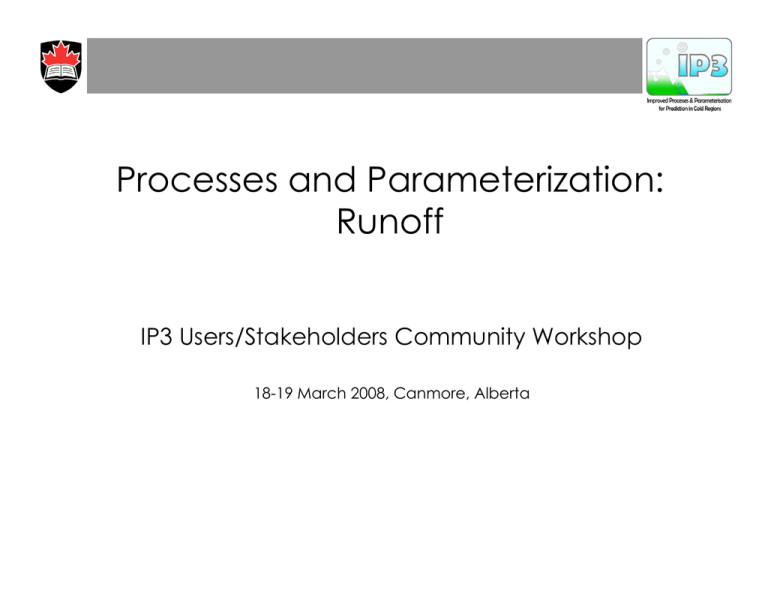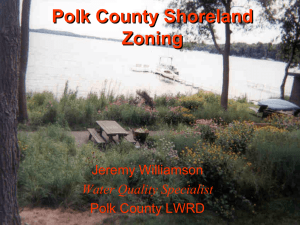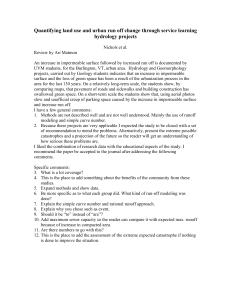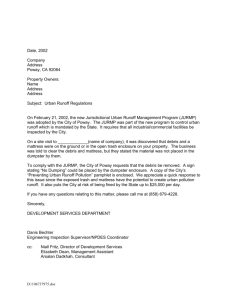Processes and Parameterization: Runoff IP3 Users/Stakeholders Community Workshop 18-19 March 2008, Canmore, Alberta
advertisement

Processes and Parameterization: Runoff IP3 Users/Stakeholders Community Workshop 18-19 March 2008, Canmore, Alberta Runoff The “left over” hydrological process Runoff 1) The total amount of liquid water leaving the region (Dingman, 1994) 2)) Water p precipitated p into a catchment that is ultimately y discharged to a stream channel (Hornberger et al., 1998) 3) i.Surface streams that appear after precipitation ii. The flow of water in a stream (McGraw (McGraw-Hill Hill Dictionary of Earth Science) 4) Runoff (or streamflow) comprises the gravity movement of water in channels which may vary in size from the one containing the smallest ill-defined trickle to ones containing the largest rivers such as the Amazon…(Ward and Robinson, 1990) 5) In hydrology, runoff is the combination of surface runoff and interflow. It also equivalent to quick flow. (Wikipedia) Runoff in IP3 We are particularly concerned with the influence of cold climate factors (snow, ice, frozen ground, permafrost, organic soils) on runoff generation and lateral redistribution of moisture. We study runoff at a variety of scales from the plot to the h HRU to the h entire i basin, b i identifying id if i emergentt properties of the system. Runoff and Global Change From Walvoord and Striegl (GRL, 2007) showing changing winter flow regime. Increases in winter flow is most notable in p permafrost regions. g Runoff and Development There are strong practical implications of runoff generation from rapid expansion of development in the west and north. Runoff - Plot and Hillslope (HRU) Studies Detailed investigation of infiltration, redistribution and soil physics that operate to generate saturated conditions and runoff. Techniques -High-frequency Sampling -Synoptic Sampling -Hydrometric -Hydrochemical Runoff – Plot and Hillslope (HRU) Studies Organic Soils 0 depth (cm) -10 -20 -30 -40 -50 50 0.1 1 10 100 1000 hydraulic conductivity (md-1) 10000 Runoff – Plot and Hillslope (HRU) Studies Infiltration and percolation is restricted when soils are ice-rich (typical of permafrost soils), soils) enhancing runoff generation. 0.1 0.0 Organic g April 28 0.1 May 2 April 24 May 2 Depth (m) 0.2 0.2 April 24 April 28 0.3 0.3 Mineral 0.4 0.4 0.5 0.5 0.6 Organic Mineral 0.6 East Slope 1998 0.0 West Slope 1998 0.0 April 30 0.1 April 13 May 10 Organic May 10 0.2 May 25 0.2 Depth (m) D In contrast, infiltration and percolation is unimpeded at dry well drained sites, even when frozen. 0.0 April 30 April 25 Mineral 0.3 0.4 0.4 0.6 0.5 0.8 Silt 0.6 0.7 North Slope 1997 0 0.1 0.2 0.3 0.4 0.5 0.6 0.7 Liquid Water Content 1.0 South Slope 1997 0.8 0.0 0.1 0.2 0.3 0.4 0.5 0.6 0.7 Liquid Water Content 0.8 Runoff – Plot and Hillslope (HRU) Studies Fall soil moisture (percent) 100 50 40 50 30 20 10 0 0 50 100 150 North Face 200 250 300 350 Valley y Bottom 400 South Face 1 0 Spring Snow Water Equivalent (mm) 100 500 50 300 100 0 0 50 100 150 200 250 300 350 400 0 Runoff – Plot and Hillslope (HRU) Studies Snowmelt Runoff (mm) 500 100 400 300 50 200 150 100 0 0 50 100 150 North Face 200 250 300 350 Valley Bottom 1 400 South Face Flow Direction 100 50 0 0 50 100 150 200 250 300 350 400 0 Runoff – Plot and Hillslope (HRU) Studies The position of the frost table has strong control on the delivery y of water to the drainage network. In cold regions, appropriate consideration of ground thermal and moisture conditions is essential 27 April 3 May 6 May 1 June Runoff – Basin Scale Interactions How do processes at the plot, plot hillslope/HRU scale “upscale” to the basin Is what we observe at larger scales explainable by our small scale observations a) b) lake c) Runoff – The Influence of Glaciers Opabin L k Lake Opabin Glacier GW outlet Runoff – The Influence of Glaciers Opabin Creek in June 2005 Runoff – The Influence of Glaciers Water Inputs and Output snow melt glacier melt rain stream flow flux (m m3/s) 1.5 1 0.5 0 5/1 5/21 6/10 6/30 7/20 2006 8/9 8/29 9/18 10/8 Runoff – the hydrograph TLR The hydrograph remains an important p element of the analysis of runoff processes, particularly at larger spatial scales. Tb TLC TLPC TLP Precipittation Tw Tc Tr twc twe Dischargge tw0 tqq0 tppk tqqc tqqe Time 3 -1 Discha arge (m s ) Runoff – the hydrograph 1.0 0.8 0.6 0.4 0.2 0.0 0.8 0.6 0.4 0.2 0.0 0.8 0.6 0.4 0.2 0.0 0.8 0.6 0.4 0.2 0.0 0.8 0.6 04 0.4 0.2 0.0 180 1999 160 140 0.35 1999 0.30 2000 2001 02 0.25 2002 2003 Runoff Ratio 2000 t* 120 100 80 60 1999 2000 2001 2002 2003 0.20 0.15 0.10 40 0.05 20 2001 0.00 0 July 2002 2003 July August September August September July August September Changes in simple parameters such as the runoff ratio and recession slope indicate strong seasonal controls in runoff response. Runoff - Thresholds T i l saturation Typical t ti overland l d fl flow process P P Fill Fill-and-spill d ill flow fl mechanism h i P P P t3 At 3 At SOF P At 3 At 2 2 SOF t2 SSSF t1 t2 SOF t3 SSSF t1 SOF A SSSF adapted from McDonnell and Taylor (1987) and Peters et al. (1995) At 3 At 3 At 2 P = precipitation A = contributing area t = time SOF = saturation overland flow SSSF = subsurface storm flow At 2 t3 t3 t2 t1 B Runoff - Thresholds May , June y , 100% 15% a) b) J l July August - September 12% e) 4% f) Runoff - Thresholds 12 < 1% chance event threshold 10 mm/d 8 eventt threshold th h ld Qo-Q Qi 6 < 10% chance 4 2 0 07-Jul-04 E 17-Jul-04 27-Jul-04 06-Aug-04 16-Aug-04 26-Aug-04 Runoff - Tracers 200 40 100 20 3500 30 2500 2000 1500 1000 500 0 May 1 0 May 16 June 1 June 16 July 1 July 16 0 25 20 15 10 5 ‐1 3000 DOC (mg L ) 60 35 ‐1 80 300 The IP3 network is strongly engaged in using tracers as a means to identify sources of water and interactions, particularly as scale increases. 0 Aug 1 120 a. -1 90 Groundwater 80 SpC (μs cm-1) 100 SpC (μs c cm ) Discharge (L s‐1) 400 4000 ‐1 100 Specific Conductance ((ms cm ) 500 Maajor Anion + Cation Flux (mg s ) Stage Dilution SpC A + C DOC 85 80 Tracers can be used in combination with hydrometric data to validate both our conceptual and numerical models of the system in question. 75 70 65 -21 -20 δ18O 60 40 20 0 -22 Organic Layer Water -20 Rainfall -18 δ O 18 -16 -14 Runoff - Tracers Event Water FFraction 1.0 0.8 GB_01 GB_02 GB_03 HRUs can be identified based on their unique geochemical signature, which is a particularly useful tool for identifying contributing areas in ungauged basins. 0.6 0.4 0.2 0.0 April 30 May 10 May 30 June 9 June 19 June 29 GB_01 _ GB_02 GB_03 GB_04 Snow Supra‐P.F. Grnd. Water Sub‐P.F. Grnd. Water ‐160 δ2H(%0) May 20 ‐170 Stable isotopes of water can be used to assess ecosystem cycling of water,, and how changes g in climate, soils and runoff processes affect that cycling. ‐180 ‐190 ‐26 ‐24 ‐22 δ O(%o) 18 ‐20 Runoff Modelling Runoff Modelling ers y a l l i o S Sub-HRUs avg. depth = 25 cm avg. depth = 15 cm avg. depth = 10 cm 10^9 25000 20000 15000 10000 5000 0 14-May Friction Factor f Requirements for each layer: •Thickness •Porosity •Specific Retention •Soil Type •Lag and Storage •Slope Drift Area (m2) 10^8 10^7 C= 10^6 ~14 ,50 0 10^5 y = -668.24x + 3E+07 R2 = 0.98 10^4 10^3 C= f = C / NR ~30 0 10^2 10^1 0.001 24-May 0.0001 0.01 3-Jun 0.1 Reynolds Number NR 1.0 13-Jun 23-Jun 10.0 Runoff Modelling Basic element of runoff and storage can be modelled, and shortcomings point to areas where future research is needed. Runoff Modelling 0.5 0.5 elevation (m m) permafrost upland no flow w 1 1 wetland 0 0 -0.5 -0.5 0 0 5 5 10 10 15 15 20 20 25 25 30 30 observation well 1 1 0.5 0.5 0 0 -0.5 -0.5 0 0 5 5 10 10 15 15 20 20 distance (m) Hayashi et al. (2005, IAHS Proceedings) 08/20/200 1 25 25 30 30 0 0 -0.1 -0.1 -0.2 -0.2 -03 -0.3 -0.3 ψ Permafrost Thank You







